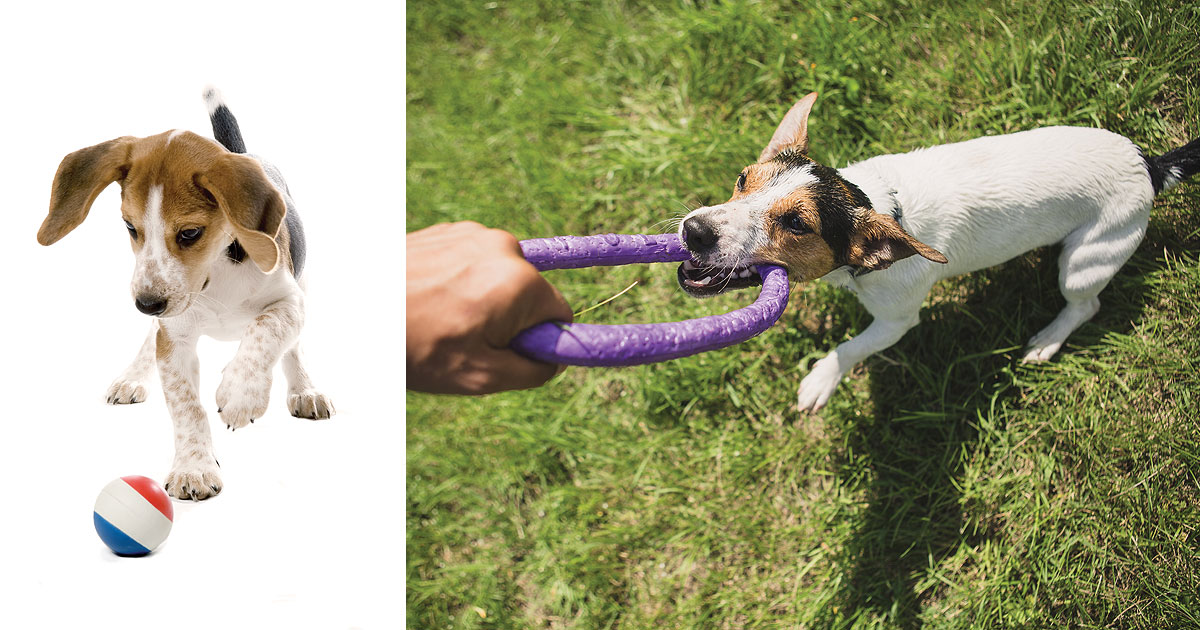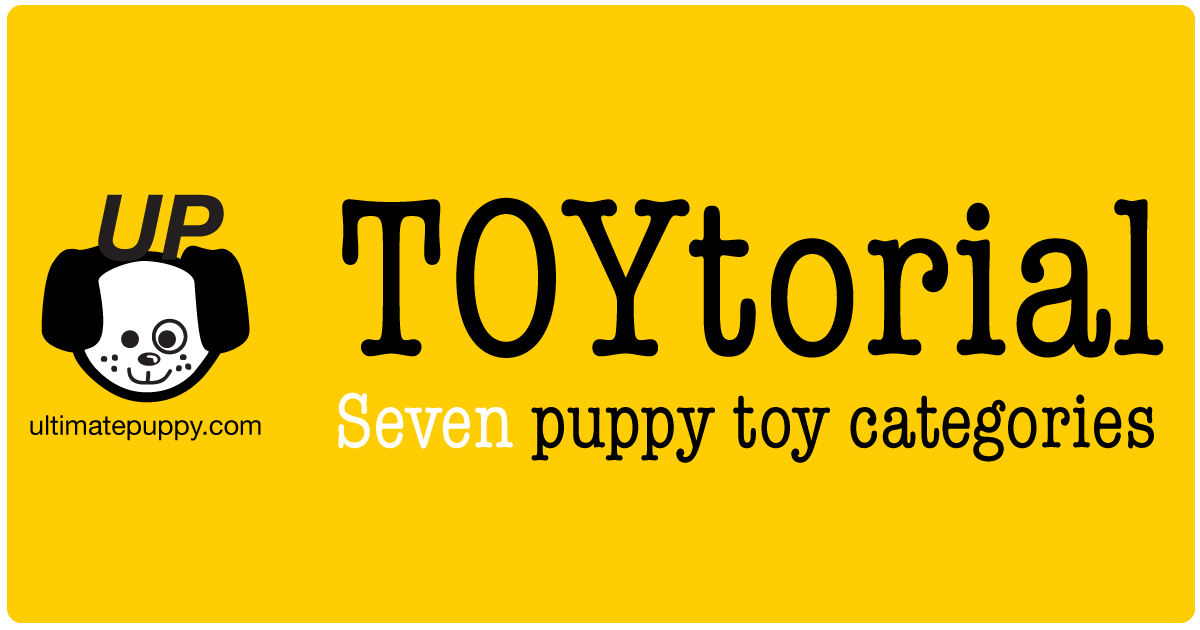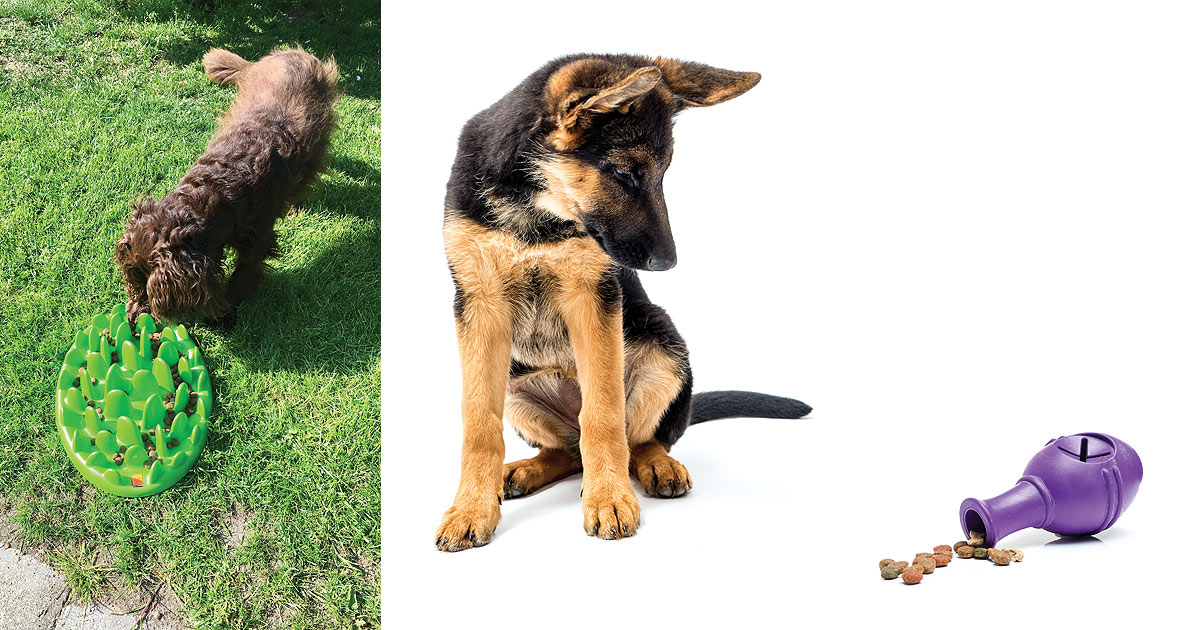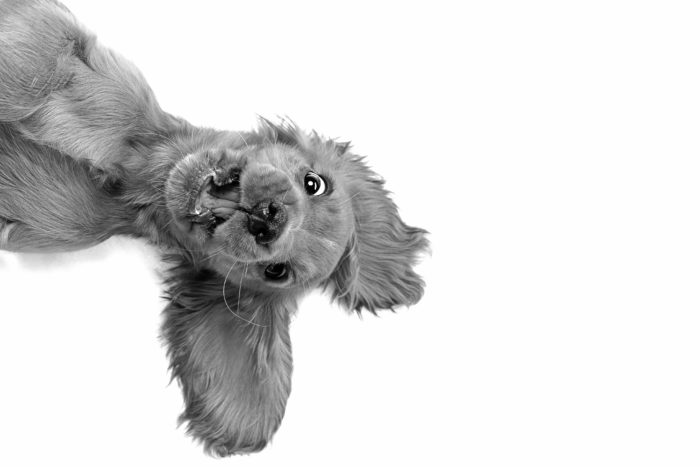
A Lesson on the Finer Points of Toys
Magic! I pull out ‘red ball’ and my border collie Fen is ‘in the game’. She is ready to work, play or ham it up. Whatever’s on the menu.
Sure, dogs love to play. Dogs love to hunt for things, forage, chase, catch and tug. This makes them prime partners in top-notch frolic. There is an art to teaching your dog how to play with you. You want your pup to recognize and use the suitable toys versus your socks, to know the rules and follow them, and to stay engaged.
Lets explore some details about toys including appropriate things for your puppy to chew on. I will refer to these as ‘Chews’. Let’s break things into categories and talk about how to use them most effectively for optimal fun and safety.
5 Components to Good Toy and Game Practice
The Right Toy for the Job
Rope toys or stuffed animals can be fun to play with but they are not the right toy when it comes to teaching a puppy to love his crate. This is a job better suited for a stuffable rubber toy filled with food your puppy loves. Plush animals and ropes can be shredded and ingested posing a threat to your pup’s health not to mention they are hardly appetizing compared to a toy stuffed with delectable chicken and pumpkin or yogurt and apple. Many young pups can’t navigate a hard rubber food-stuffed toy so they give up. A softer or easier toy to start off with will help teach the puppy the joys of working for their food. A tiny stuffed toy is not the right toy to play a good game of tug with. A longer rope with room for your hand to be at a safe distance from the puppy’s mouth is more suitable. A tiny ball is not safe for a larger dog. Using the right toy for the job is very important; it contributes to effectiveness of teaching and training as well as to optimal fun and safety. Finding the right toy for the job is reinforcing for both you and your pup.
Variety
Warning, accumulating a collection of different toys for your pup may become habit. I LOVE buying dog toys. I frequently have to will myself to keep walking past the toy section, or not. Having a variety of toys is fun and helps keep things interesting. Your pup will grow to have his favorites.
Preferences
Before you go crazy buying toys for your pup it is a good idea to learn his preferences. This will come with getting to know your pup, experimenting and paying attention to what toys and games they love. Remember your puppy decides what is reinforcing.
Storage
Keep your dog’s toys stowed away. Trunks, baskets on top of crates or in a drawer are some good options. Safe storage helps keep toys off the ground, aids in keeping the dog interested in toys and helps prevent the destruction of toys left unattended with a pup.
Safety
Pick up all the dog toys. Avoid leaving any lying around. The toys you play with together should get put away when the game is finished. The toys that are safe to chew on like food stuffable toys and appropriate bones and other ‘animal bits’ can be given to the pup to chew but you should still check on the puppy frequently. When he is not chewing they should be picked up. Rubber stuffable toys with an opening and an additional air hole are safe for crate time with the puppy. Toys and chews should be inspected regularly for loose bits and wear and tear. As bits from the chews get gnawed down they should get thrown out so the pup doesn’t ingest anything that could be a choking hazard.
A Toy’s Purpose
Toys serve many different purposes. They can entertain your pup when you can’t. They can be therapeutic in nature providing chewing, gnawing or foraging opportunities for your puppy. You can play awesome games together using toys. The fun and lighthearted nature of games is superior when it comes to teaching your puppy new things. Not only is holding a chew, as your puppy gnaws it, a nice way to bond; it is also an opportunity to work on exercises to help prevent resource guarding. Games like retrieve, tug and hide and seek give your pup the opportunity to exercise their predatory chops. Some dogs may find toys more reinforcing than food when it comes to training. Toys serve many worthy purposes for lots of different jobs. Learn to be toy savvy.

- Things to throw Balls and discs. There are so many different styles of balls for your dog to play with, all of these toys should be brought out to play with and put away after the game. Soft mesh rubber balls are great for pups – choose appropriate sizes. Avoid tennis balls, which will act like sandpaper on the dog’s teeth, not to mention the chemicals used in these ball. My Puppy Pick… JW Pet Hol-ee Roller
- Things to play tug with Ropes, fleece ropes, rubber rings or long soft plush unstuffed toys for puppies. The main thing here is that your puppy likes it and that you have ample space for hand safety. Tug is a fantastic game to teach your puppy.
- Stuffed animals Soft plush toys and snuggle toys. Sometimes these toys have a squeaker in them. These toys are frequently shredded and chewed by dogs and sometimes ingested. They are super-cute and fun to play with but be sure your dog is not going to chew it up. They certainly aren’t my first pick for leaving in a crate or pen with a pup. I think they are better suited for indoor retrieve.
- Food Stuffable Rubber Toys – Food Balls and other food dispensing toys – Puzzles, and snuffle mats (AKA work-to-eat toys)Stuffable rubber toys, food balls and other food dispensing toys and puzzles all have something in common. They provide your dog with the opportunity to work for their food. Foraging and working or searching for their meals, treats, or just for a fun game is fulfilling for your dog. Dog food bowls are the biggest waste of time. Why feed your dog from a bowl when you can use his food to provide this enriching opportunity. There are many popular examples of a food stuffable toy. My Puppy Picks… West Paw Toppl Treat ToyOmega Paw Tricky Treat, Nina Ottosson is the Queen of the dog puzzles
- Squeakies Pups respond to rapidly repeated, short burst, high-pitched sounds. Enter the squeaky toy. These can be most helpful in getting your puppy’s attention. They can help with a lagging puppy learning to walk on a leash. They can help speed up a dawdling recall or chase me game. Plus they are just fun to play with, toss around, or let your pup run around and squeak. They come in all types of different shapes and sizes and materials.
- Chews A bone produced from nylon does not a good chew make. Would you like to chew on nylon? Do you really want you puppy ingesting nylon or some other bizarre man made material. Chews should be biologically appropriate for your dog to ingest. They may be given raw, baked, smoked or dried. They include but are not limited to hooves, bullies (bull penis), Beef knuckles and marrowbones, chicken feet and necks. My Puppy Picks… Bullies, hooves smeared with goat cheese, yak cheese sticks, smoked knuckle bones
- Grippers to hold chews These are rubber toys that you can jam a ‘bully’ or other animal bit into and they grip the chew tightly. They add a layer of safety since the pup will not be able to swallow the small part left inside the gripper. It also gives the dog something to hold on to as they gnaw away. Example… Orbee Tough Nooks
A word on animal bits
It might be gross to you but to your dog gnawing on a big raw meaty bone can be one of the most satisfying parts of his day. I encourage you to learn about the benefits of providing this type of chewing for your dog.
Give a dog a bone
Often people are surprised that they might have to do some introductions to get their pups into bone-chewing mode.
Hold the bone at first and let the dog sniff it if he acts disinterested smear a little something tasty like goat cheese on the bone. It shouldn’t take long for your pup to start to learn to enjoy. For the first handful of sessions hold the bone as your pup chews on it. Since bones are often very high value items to dogs they can be most helpful in crate training game plans and are also good aides in helping to keep your dog’s teeth clean. Finding a good pet supply store that can educate you about bones and keep you in good supply with healthy chews is a smart move.
Safety Considerations
- As with all toys, bones and other animal bits must be managed carefully and small pieces that could pose a choking hazard should be taken away.
- If your dog has shown signs of guarding, a raw bone is not advisable. They are very high value items and the dog may become stressed at the prospect of you taking the bone.
- Always work with the help of a certified professional trainer if you are dealing with guarding issues with your dog.

Toy Stuffing Tips
- Think Goldilocks; you want the food to come out just right. If it is too hard to get at, the dog will give up, too easy and he will be finished too quickly. Stuff it just right and he is reinforced and satisfied. Honing your toy stuffing skills will take some time and consideration. Learn you pup’s preferences, get creative and use your imagination.
- Anything that is healthy and safe for your dog to eat can be stuffed in a toy, chicken, pumpkin, yogurt, sweet potato, apple, banana, strawberries, blueberries, cheese, turkey, chicken stock (then freeze).
- Need some inspiration? Check out Kong’s recipe section. You will find lots of shared recipes on other sites too if you do a search for dog toy stuffing recipes.
Games
Any of these toys can be used to play fun games with your dog. There are rules to playing games. Rules for you to follow, and rules your pup needs to follow.
Your Rules
Stay engaged with your dog; keep your head in the game.
Quit the game (especially when teaching a young pup) while they are still engaged. You will build on this as the pup’s attention span grows.
Put the toy away after the game is over.
Pup’s Rules
Teach your pup the give/sit cue so he doesn’t jump for the toy.
If he bites too hard while playing and gets your skin, stop the game.
If he quits on you – the game is over.
Tip – teach your puppy to play outdoors too. This ensures you can have a good game of retrieve in a field or park or a fun game of hide and seek or tug in the vet’s office.
Inexpensive ways to create DIY puzzles
Brown cardboard TP or paper towel rolls can make a great toy. Fold one end. Drop in a handful or kibble or treats, fold over the other end. Punch a couple holes in the tube and let your pup have at it. The same game can be played with a brown paper egg carton. Drop treats in a muffin tin and cover with balls. Uses a couple of old towel tossed on the floor, create creases and crevices to drop treats into.
In my practice I consider games of greater importance to condition sooner in a young pup than some of the everyday moves like down or loose leash. Everything is important but if you focus on providing these fun outlets for your puppy it is bond building and so enriching for your relationship. This will benefit every aspect of raising a pup. Learning your puppy’s preferences when it comes to toys and games and chews is a win-win endeavor.
Over to You
What are your dog’s favourite toys? Do you have any toy stuffing recipes or DIY dog toy project you’d care to share?

